The Beginnings of the Fuji X-Pro1:
When the Fuji X-Pro1 was first announced a few months ago, people went crazy for it. There was good reason for this because here was a camera that Leica should have produced a long time ago: a camera that offers great image quality and most importantly, the rangefinder experience all for a reasonable price. I was excited about the X-Pro1, and I was eager to try it out, and see if they vastly improved on the already excellent X100.
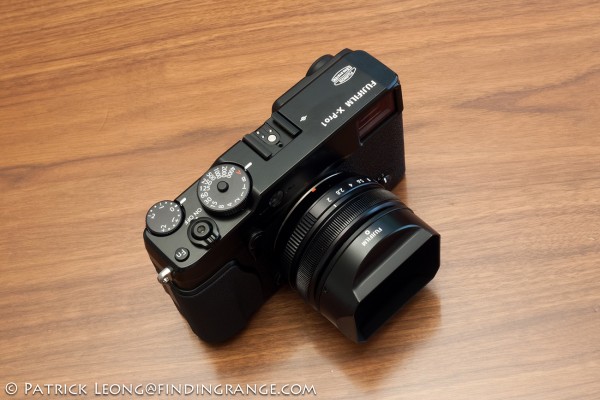
↑ Top view of the Fuji X-Pro1.
Speaking of the Fuji X100, as many of you know, it was a huge success. There were waiting lists everywhere, and some people had to wait months to get their hands on one. It definitely hurt Leica X1 sales because it offered something Leica would not on the X1: rangefinder styled usability. It really seemed as if Fuji hit its target: a rangefinder styled camera, that performed well, and produced beautiful images.
But not everything was as perfect as everyone initially thought. There were a few bugs and issues that plagued the X100, and to this day, still annoy me. Plus, I definitely do not think that the X100 lived up to all the hype Fuji kept feeding to us. For instance, image quality is very good but I still don’t believe that it’s better than the X1. Build quality is great, and the viewfinder is beyond excellent but for some reason, the X100 always feels more like a point and shoot rather than a…dare I say a “real” camera to me. This is not an attack on the X100 in any way. It’s just how I feel. Still, the X100 is a great camera, and one that I am proud to own because the overall package is excellent. But I won’t lie. I wanted a little more out of the X100 because I saw its potential, and I’m sure many other Fuji users did as well. Fuji’s answer for all of us is the X-Pro1.
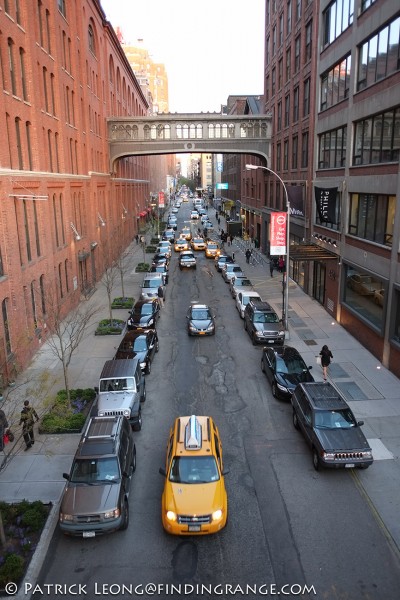
↑ Fujinon 18 F2.0 XF lens shot at F2.0.
But how is the new Fuji X-Pro1, really? Does it make up for past mistakes of the X100? Does the Fuji X-Pro1 improve on the X100? One thing I was a little annoyed about was the amount of hype Fuji was feeding to us about the X100. I feel that they definitely fed us more hype with the Fuji X-Pro1. But does the Fuji X-Pro1 live up to its hype? Find out by reading below :).
Fuji X-Pro1 Build Quality:
Build quality of the Fuji X-Pro1 is excellent just like with the X100. There are absolutely no creaks or rattles. It’s a solid camera. However, one thing that I should mention is that everything is really light…definitely lighter than I expected. First impressions was that Fuji probably had to make some sacrifices in order to keep the price low, in order to be able to offer all of the features in the X-Pro1 because I feel that the X100 used slightly better materials. Things feel slightly more hollow with the X-Pro 1. In fact, I feel that the X100 weighs slightly more but that might just be my imagination. The X100 just feels a bit more dense to me. I feel like my chrome 50 Summilux ASPH weighs more than a X-Pro1 and lens attached.
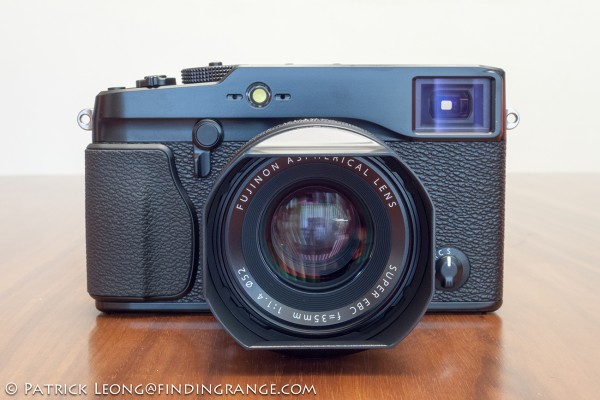
↑ Front view of the Fuji X-Pro1. In person, the X-Pro1 is a beautiful piece of machinery.
Speaking of the lenses, they’re also very light. They feel like they are made out of plastic, and in some ways, they feel a little hollow as well. For $600 each, I was not expecting this, and I have to admit, I was a little disappointed. But maybe Fuji decided to use the money for the optics, and their is some evidence of this because the images shot with these lenses are superb. If I had to choose, I personally rather have a camera company spend the money I give them on the optics of the lenses rather than just having them build heavier lenses with higher quality materials that perform poorly. Don’t forget, it’s all about the photography. Plus, if you want lenses with high quality optics built from something like brass, then buy Leica but be prepared to spend several thousands of dollars for each lens.

↑ Back view of the Fuji X-Pro1.
In practice though, the Fuji X-Pro1 really feels well balanced, and the lightness actually works for it. My wrist does not get tired at the end of the day shooting with the X-Pro1. The weight distribution of the lenses and body are also very evenly distributed making the camera a joy to hold and use. For me, the grip that comes with the X-Pro1 is good enough. I had no issues whatsoever with it. It was actually perfect. Overall, the Fuji X-Pro1 is a great, GREAT camera, and it will be a perfect companion if you’re the type of person that goes out shooting from morning to night.
Fuji X-Pro1 Image Quality:
Images from the Fuji X-Pro1 are breathtakingly superb. There is really not much more to say than that. Because of the lack of an AA filter, and the spectacular Fuji lenses, you get images that are sharp, crisp, and extremely detailed. Color is nice and contrast is great. Images have a similar signature to the Fuji X100 but the quality is a lot better. While good, I always felt that the image quality of the X100 could have been a little better especially from all the hype I read about it. This new Fuji definitely delivers the goods. Images look so clear and refreshing. If you ask me, Fuji’s asking price for the lenses and body are completely well worth it in terms of the image department. I’m really impressed with what the Fuji X-Pro1 offers, and I still haven’t even fiddled with the RAW files yet.

↑ Ipad photographer shot with the Fujinon 35 F1.4 XF lens wide open in Times Square. Unfortunately, I don’t have ND filters for the lenses yet.

↑ Fujinon 35 F1.4 XF lens shot at F1.4. I find that the Fuji X-Pro1 system produces very three dimensional images.
If you want to know more about Fuji’s new sensor for the X-Pro 1, please read below. It was taken directly from Fujifilm’s X-Pro1 site.
Fuji X-Pro1 APS-C 16MP X-Trans CMOS Sensor
Moiré is tackled at its root cause by the innovative color filter array of the new sensor. By enhancing the aperiodicity (randomness) in the array arrangement, the color filter minimizes the generation of moire and false colors, eliminating the necessity for an optical low-pass filter in the lens and enabling the sensor to capture the full “unfiltered” resolution and descriptive quality of the XF lens.

↑ Fujinon 35 F1.4 XF lens shot wide open. I just love how clear the photos look with the X-Pro1.
Fuji X-Pro1 Hybrid Multi Viewfinder:
I must admit that I am not a big fan of EVF’s, and for people like me, Fuji also offers a beautifully bright and clear optical viewfinder with a simple push of a button. This is a real viewfinder, just like the one on the Leica M9. This is not a small, and dark viewfinder that was a simple afterthought. This in my opinion, is one of the key features that makes the Fuji X-Pro1 such a great camera. Having a viewfinder as good as this only helps you get more into the scene, and take better photographs. Good viewfinders helped build Leica’s reputation, and it’s clear that Fuji is doing the same. This is a really good start. Viewfinders as good as this one are a rare occurrence these days, and something like this should definitely be praised.

↑ Switching from OVF to EVF is easy on the Fuji X-Pro1.
The X100’s was just as good but what separates this viewfinder from the X100 is that both the viewfinder magnification and bright frame size automatically switch to support, whichever lens you choose to attached to the X-Pro1. Viewfinder magnification switches from 0.37x with the 18 F2.0 XF lens on, and to 0.60x for the 35 F1.4 XF, and 60 F2.4 XF lenses on. If you don’t like frame lines, you can get 100% coverage by switching to EVF.

Fuji X-Pro1 Lenses:
I’m sure that many were completely taken by surprise when Fuji announced the lenses that were going to initially be shipped with the X-Pro1: an XF 18mm F2.0, an XF 35mm F1.4, and an XF 60mm 2.4 Macro. I definitely was taken by surprise but pleasantly :). It looked as if Fuji meant business because all of these lenses are fast primes! These Fujinon XF lenses are not only fast primes, Fuji also took the classic rangefinder approach because if you get all three, you’ll have the 28-50-90 lens spread. So far, I only have two because they haven’t shipped out the Macro yet. I will be doing individual lens reviews for each lens but for now, I will give you all a mini review of each.

↑ My Fuji X-Pro1 system so far. It kind of reminds me of a Mamiya 7.
If you want to know more about Fuji’s new lens system for the X-Pro1, please read below. It was taken directly from Fujifilm’s X-Pro1 site.
Fuji X-Pro1 FUJINON Interchangeable XF Lens And Original X Mount
Designed especially for the X-Pro1, the FUJINON XF Lens series promises enhanced resolution and light volume in image edge areas as well as reduced chromatic aberration for exceptional image quality. Featuring an all-glass aspherical lens and other elements, the lens is polished to perfection and treated with Super EBC coating. Holding the high-quality metal barrel and operating the precision-machined 1/3-step aperture ring is a sensation that fires the desire to capture every scene. For photographers who seek the peak of photographic excellence, FUJIFILM raises the curtain on a new era of interchangeable lenses and unveils a premium lineup of 3 single-focal length
1. The Fuji 18 F2.0 XF Lens For The X-Pro1

↑ Top view of the Fuji 18 F2.0 XF lens.
As of now, the 18 F2.0 XF lens is the smallest and lightest X-Pro1 lens that you can get right now. It’s approximately a 27mm on the X-Pro1, and it’s Fuji’s answer to the pancake lens (although I heard rumors that Fuji is going to come out with a 35mm equivalent lens that they refer to as pancake). It also focuses a bit faster than the 35mm. I really enjoy using this lens even though I generally don’t like the 28mm focal length. It might not have the same effect as the 35mm at F1.4 but it’s definitely sharp, with very nice contrast. Nothing to complain about with this lens. I also find that the photos coming from it are very three dimensional, and the colors are nice. I know there are many who prefer the 35 F1.4 XF lens over this one but I don’t believe that the 18mm should be overlooked. It is true that I use the 35mm over this one more frequently but don’t forget; if you’re frequent visitor of this blog, you’ll know that I generally prefer the 50mm focal length over any other focal length. I genuinely love using this 18 F2.0 XF lens, and I urge you to not overlook it.
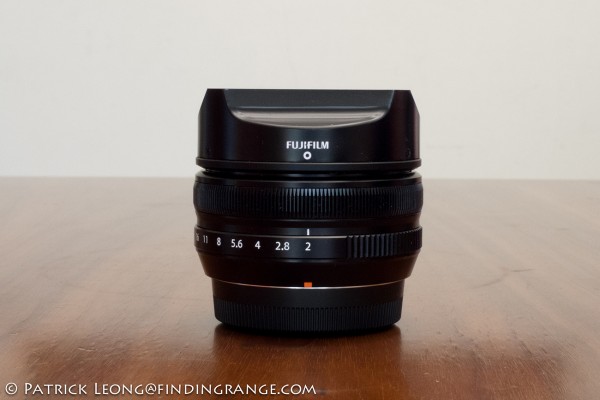
↑ Side view of the Fuji 18 F2.0 XF lens.
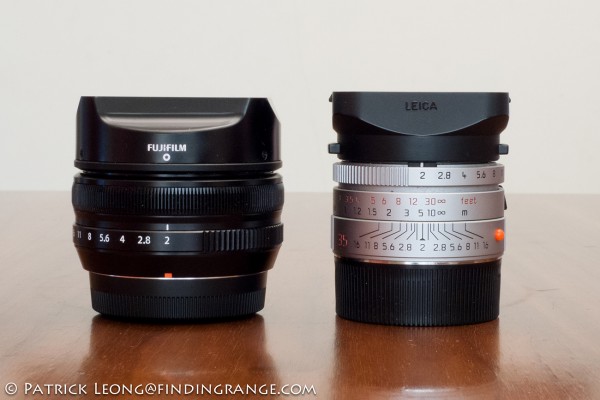
↑ Side by side comparison between the Fuji 18 F2.0 XF lens and the Leica 35 Summicron ASPH.

↑ Fujinon 18 F2.0 XF lens shot at F16. The color, and contrast are excellent. Some of the details have a very three dimensional quality to them.

↑ 100% crop to show you the detail on the chair.

↑ A Macro shot taken with the ↑ Fujinon 18 F2.0 XF lens shot wide open.

↑ Here is a 100% crop to show you the sharpness, and details of the fingers.

↑ Fujinon 18 F2.0 XF lens shot at F5.6. All these photos in this review are jpegs that came straight out of the camera with no editing. However, I did use Nik Software Silver Efex Pro 2 to convert this photo into black and white.
2. The Fuji 35 F1.4 XF Lens For The X-Pro1

↑ Top view of the Fuji 35 F1.4 XF lens. This is a great first lens for the Fuji X-Pro1.
The 35 F1.4 XF lens is a wonderful piece of glass. It’s stil a little light for my tastes, and a little big (bulky) but it is a wonderful performer. This lens renders beautifully at F1.4. Colors are nice, and images look creamy, and very sharp. If I only had one lens to choose from for the Fuji X-Pro1 system, this would be it because it is so utterly versatile. It’s great as a landscape lens, great for portraits, awesome for street, and a great companion for night shots. With this lens mounted, you probably won’t need to go past 1000 ISO for night shots; not that it matters with the Fuji since the high ISO is so incredible. But I’m an old school photographer, and I always try to shoot at the lowest ISO possible. This lens will be your best friend at night.
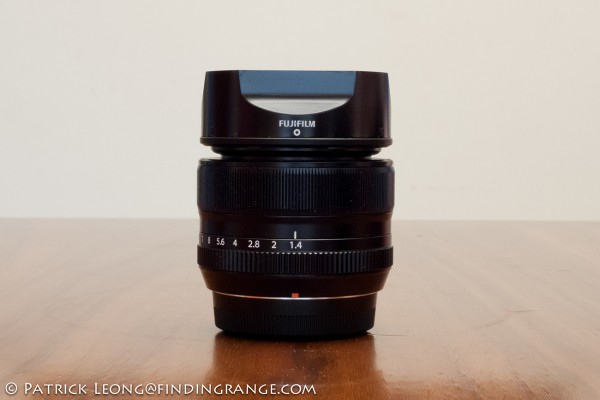
↑ Side view of the Fuji 35 F1.4 XF lens.

↑ Side by side comparison between the Fuji 35 F1.4 XF lens and the Leica 50 Summilux ASPH.

↑ Fujinon 35 F1.4 XF lens shot at F1.4. Again, I haven’t bought any ND filters yet.
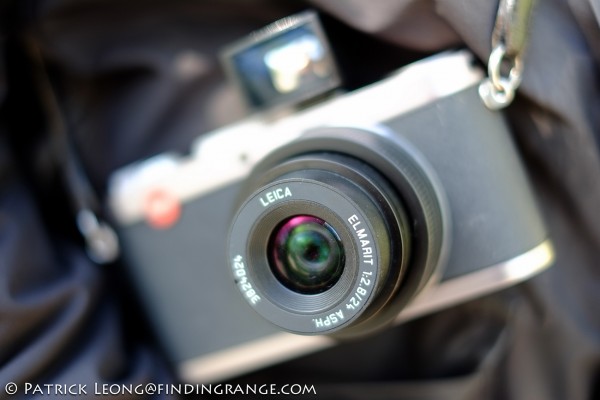
↑ Macro shot of the Leica X1 taken with the Fujinon 35 F1.4 XF lens shot at F1.4.
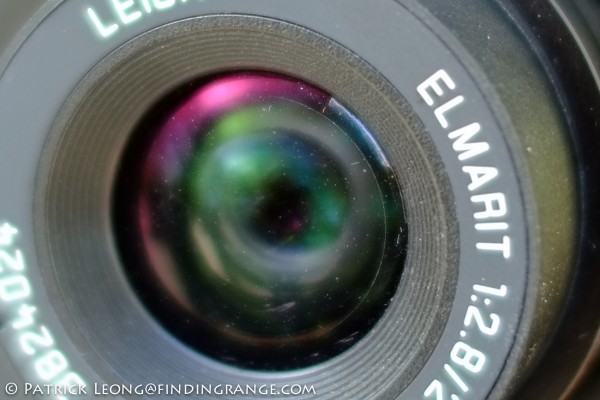
↑ Here is a 100% crop of the photo above showing the little details, such as, the dust on the lens.

↑ Fujinon 35 F1.4 XF lens shot wide open.

↑ Fujinon 35 F1.4 XF lens is all about the details. You can see the bits of dust in the golden retriever’s hair lying on her forehead even though that’s not the part I focused on.
Another thing that I found is that the 35 XF F1.4 lens is very cool when used in macro mode. In fact, I have been using the macro mode a lot with this lens, and I love the results! I wanted to use macro mode with my 50 Summilux ASPH but never had a chance for obvious reasons. The 35 F1.4 XF lens has made that dream come true :). I did some portraits with this lens at F1.4 in macro mode, and I think that they look so cool. This is a great lens, and easily worth the $599 asking price.

↑ The Bokeh is beautiful on this lens. The bokeh is very smooth. Fujinon 35 F1.4 XF lens shot wide open.
Problems With The Fuji X-Pro1 Lenses:
Both the lenses that I’ve been able to test out with the Fuji X-Pro1 are exceptional performers. However, there were a couple of issues worth mentioning. These issues are only minor but I’m just mentioning them because this is a review, and I thought you all might want to know what I experienced with the lenses.
1. Rubber Caps For The Fuji X-Pro1 Lenses
First off, I hate the rubber lens caps that are designed to go over the lens hoods. Was Fuji copying Leica just for the sake of copying Leica? As many of you know, Leica has similar functioning caps for lenses, such as, the 28 Elmarit ASPH and the 35 Summicron ASPH. I know a few people who lose those caps quite frequently. The one for the Fuji are worse. They are really big, cumbersome, and the edges of the caps constantly hook onto the sides of my bag every time I put them back in my bag. They always end up popping off.
2. Fuji X-Pro1 Lens Chatter And Shutter Sound:
When I first bought my X-Pro1 system, I thought something was broken because the lens chatter is so loud. I looked into the lens and discovered that it’s from the movement of the aperture blades as light changes. I don’t usually complain about stuff so small but this is pretty annoying. It’s pretty loud. Think about it: Fuji designs this wonderful camera to shoot like a rangefinder. A rangefinder is suppose to be discreet. Imagine if you’re interviewing someone in an intimate setting, and then you decide to photograph them. You don’t think the constant sound of chattering coming from your aperture blades will kill the atmosphere? I don’t even know why it does it, especially since everything is set to manual. Hopefully they can maybe reduce this with firmware or something.
Fuji X-Pro1 High ISO:
I rarely pass 1250 ISO but for the sake of testing, I took a few photos at 3200 and 6400 ISO. The high ISO on the Fuji X-Pro1 is simply amazing. No one could possibly want more from any camera. I will be doing a future post specifically on the X-Pro1’s high ISO capability but it’s safe to say that you will have no trouble shooting at 6400 ISO all the time if you wanted too. Below are a few shots at high ISO.

↑ This photo was shot with the 35 F1.4 XF lens at 6400 ISO. The X-Pro1 simply has incredible high ISO capabilities.

↑ Here is a 100% crop of the photo above. Check out the detail. You can see the dust floating above golden retriever’s head.

↑ This photo was shot with the 35 F1.4 XF lens at 3200 ISO.
↑ 35 F1.4 XF lens at 6400 ISO.
Fuji X-Pro1 Slow AF Speed?:
It’s true, the X-Pro1’s AF speed is not the quickest in the world but it’s not bad at all. I refuse to jump on the bandwagon saying that the AF speed is slow because I honestly find it just fine. In fact, I find it like a vacation since I’m use to manually focusing my Leica lenses often wide open :). It’s perfect for street shooting. Seriously, how fast did any of us expect the X-Pro1 to be? It’s sure not going to be Canon 5D speed, and that’s ok. It doesn’t need to be for what it’s meant to do. You have to remember that this camera was designed for you to take your time to compose a photograph, not shoot multiple frames per second hoping you’ll get the shot. Remember “the decisive moment?” This camera is designed for that stuff. In that way, it follows the rangefinder experience. You have to pre-plan your shots just like you would on a Leica M9, and not take multiple shots hoping you’ll end up with the decisive moment. You’re not trying to capture the whole moment; you just want the decisive one :). The Fuji X-Pro1 is a thinking man’s camera, and that’s why I really appreciate it.

↑ Fujinon 35 F1.4 XF lens shot wide open. The autofocus on the X-Pro1 could still keep up with this group exercising.
I also had no issues shooting at night with the X-Pro1. If you were to shoot in total darkness, then maybe you might have a problem but who shoots in total darkness? It frustrates me a little hearing about the slow AF speed in some reviews or forums because I don’t have any problems with it, and sometimes I think it prevents people from even giving a chance to a camera as wonderful as this one. Seriously, the Fuji X-Pro1 is a real keeper. If you’re really worried about AF speed, I think you should really go to a camera store, and try one out in person. Who knows, maybe it might be to slow for you but just give it a chance. It’s seriously not as bad as some make it out to be, and I’ve gotten all the shots that I’ve wanted too.

↑ Fujinon 18 F2.0 XF lens.
If you must get faster AF, just wait because Fuji will probably come out with firmware that will make your AF faster. Leica did that for their X1, and Fuji did it for their X100. Fuji updates their firmware quite frequently, which is also a plus for the X-Pro1. I honestly don’t think the AF speed is any reason to dismiss this camera especially since this camera is designed for rangefinder type shooting.

↑ Fujinon 35 F1.4 XF lens shot in Central Park. The autofocus is really not bad on the X-Pro1.
Fuji X-Pro1 Film Simulation:
I never used any of these film options before on the X100 but since Adobe Camera RAW does not support the X-Pro1’s RAW files, I decided to give it a try. In fact, most of my images here were shot with the Velvia film option (I was a huge Velvia fan back in the days 🙂 ). Here are some sample film options that you can choose from:
Fuji X-Pro1 Provia/Standard

Fuji X-Pro1 Velvia/Vivid

Fuji X-Pro1 Astia/Soft

Fuji X-Pro1 PRO Neg Hi

Fuji X-Pro1 PRO Neg Standard

Fuji X-Pro1 Monochrome

Fuji X-Pro1 Monochrome + Ye Filter

Fuji X-Pro1 Monochrome + R Filter

Fuji X-Pro1 Monochrome + G Filter

Sepia

How Does the Fuji X-Pro1 Compare to Leica M9?:
When rumors of the Fuji X-Pro1 first surfaced, the first thing I remember reading was “Is Leica in trouble?”. The X-Pro1 might not be in the same price league as an M9 but there are many similarities between these two cameras that no one can deny. Well, I’m going on record and saying, sorry Fuji fans but this camera’s build quality, usability, and image quality (except high ISO) are not equal to an M9, and this is not because I’m a fan of Leica. In fact, I’m a little frustrated that my sensor is cracked in my M9, and Leica is all backordered on sensors. I love the X-Pro1, and I’m a huge supporter of this new camera system. I’m just stating fact though, and it’s not like I have anything to gain because I own both of them. The files from the M9 are not only sharper, they are also smoother. Files from the M9 also look more organic, less digitized, and more film-like.

↑ Comparison between the Fuji X-Pro1 and the Leica M6 TTL Millenium. My M9 is currently at Leica NJ.
But then again, we also have to keep in mind that the Fuji X-Pro1 was not designed to compete with the Leica M9. They both might have similarities but it ends there. The X-Pro1 was designed to compete with other interchangeable mirrorless cameras in it’s own price range, such as, the Sony Nex-7 or the Olympus OM-D. People who are going to buy a Leica will always buy a Leica. If someone has enough cash to buy a Leica, they will go buy the Leica. But in terms of its class, the Fuji X-Pro1 rocks, and this is the camera that I would definitely get over its competitors do to the X-Pro1’s unique combination of usability, rangefinder styled features, build quality, and most importantly, image quality.

↑ Fuijnon 35 F1.4 XF lens shot wide open.
If you really want the Leica M experience, and you don’t want to shell out the money for an M9, I suggest that you buy a used Leica M8. The Fuji X-Pro1 in many ways is similar to the M experience but it will never give you the M experience. That’s ok, because it’s not designed to give you that. The X-Pro1 is designed to give you something similar to the Leica but also add some of it’s own character into the mix. This is what gives the X-Pro1 personality. I hope this doesn’t turn anyone away from this wonderful camera. It’s really a joy to use. For it’s price, if you want something new, the Fuji X-Pro1 will probably be the closest to a rangefinder as you’re ever going to get. If I had to choose between the M8 and Fuji, I would choose the X-Pro1 in a heartbeat.
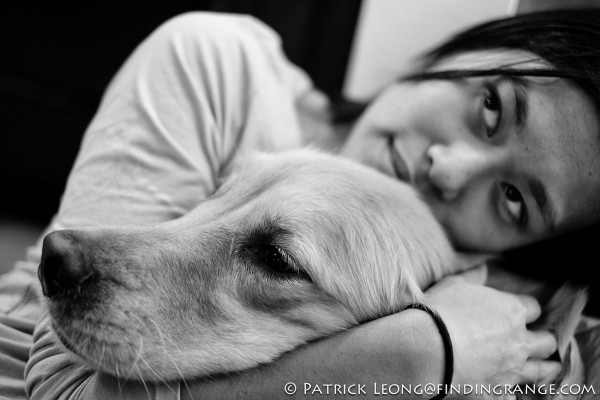
↑ Fujinon 35 F1.4 XF lens shot at 1600 ISO. Again, this is a jpeg straight out of the X-Pro1 with no editing but I used Nik Software Silver Efex Pro 2 to convert it to black and white.
One last thing that I want to mention is that while the Fuji X-Pro1 is in the mirrorless class, in a way, it doesn’t really have any competitors. The X-Pro really is unique in it’s class. It offers a true rangefinder styled experience unlike the Sony Nex-7 or the Olympus OM-D. You actually hold the X-Pro1 to your face, and look through a beautifully bright optical viewfinder. I honestly hate cameras that depend primarily on the stupid screen in the back, and while you can still use live view on the Fuji X-Pro1, it also offers you a choice of EVF or OVF. That is one of a kind, especially in the mirrorless class.
Fuji X-Pro1 vs. Fuji X100:
How does the Fuji X-Pro1 Compare to the Fuji X100? First off, I will be doing a more in-depth comparison between the X-Pro1 and the X100 at a later date but for now I will give you some basic differences that I see so far.
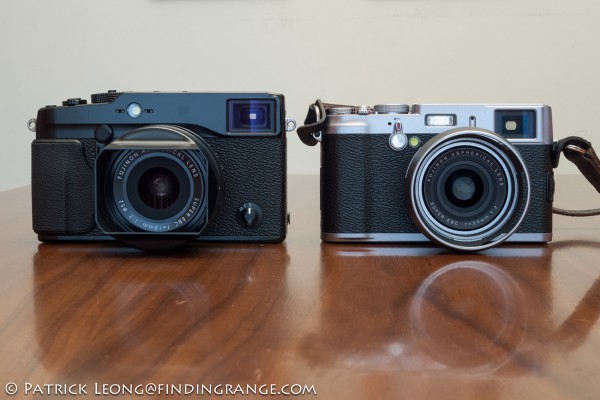
↑ Comparison between the Fuji X-Pro1 and the Fuji X100.
I want to start off by saying that after purchasing the Fuji X-Pro1, I am most definitely going to sell my X100. I find almost everything to be better with the X-Pro1. Yes, it’s bigger but not by much. Don’t get me wrong, I don’t want to be attacked by X100 users :). It’s part of life; technology gets better, and it only makes sense that the X-Pro1 would be better. The X100 is a great camera but it’s a camera that I only liked, not loved. In my opinion, this is the camera that I think Fuji should’ve came out with in the first place. It’s the camera I’m pretty sure many wanted from Fuji especially for the ability to interchange lenses. The X-Pro1 has better high ISO, it focuses faster especially in lower light, and again, it offers the ability to interchange lenses. They also fixed the annoying scroll wheel by taking it out, and replacing it with buttons. I know that I wasn’t the only one who found it sometimes difficult and annoying to scroll through the menu with the X100’s small, and overly sensitive scroll wheel. Plus, the biggest update for me is fixing the painfully slow boot up time on the X100. That is probably the biggest issue that I have with the X100. There were so many times the camera fell asleep, and when I lifted it up to my face, nothing would happen even after repeated depressions on the shutter button. I missed many shots that way.

↑ Fujinon 35 F1.4 XF lens shot at F1.4. I can’t wait to get the 60mm Macro for the X-Pro1.
In terms of image quality, while it is great on the X100, it’s better on the X-Pro1. The X100 photos are sharp, and it produces beautiful images but it just lacks a little pop when compared to the X-Pro1. This is just all my opinion, and I’m just trying to be honest. Again, I still have both cameras so it’s not like as if I have anything to gain or lose. I genuinely love the images that come out of the X-Pro1, and I haven’t even had a chance to check out the RAW files yet.
Pro’s and Con’s of the Fuji X-Pro1:
Here’s a list of pros vs. cons of the Fuji X-Pro1. This is just a quick summary of what I wrote.
Pros of the Fuji X-Pro1
- The biggest pro is IMAGE QUALITY. The files are outstanding.
- Jpegs out of the camera are excellent.
- High ISO is incredible. You can easily shoot as high as 6400 ISO, and achieve excellent results.
- The optical viewfinder is big, bright, well built, and functions extremely well.
- Both the viewfinder magnification and bright frame size in the viewfinder automatically switch to support, whichever lens you choose to attached to the X-Pro1.
- The whole camera system is extremely light, and can be carried all day long with ease.
- The whole camera system is well built.
- The X-Pro1 is stealthy and small, which makes it perfect for discreet shooting.
- The X-Pro1 overall design was built on an already excellent foundation (the X100) but with significant improvements over it’s predecessor.
- Camera is very user friendly
- Price is reasonable for the quality of images that you can get out of this camera.
Cons of the Fuji X-Pro1
- The aperture blades constantly chatter loudly.
- No Adobe Camera Raw compatibility yet.
- The overall camera system might be too light for some.
- The lens cap designs are bad.
Is the Fuji X-Pro1 Worth It?:
I wholeheartedly think the Fuji X-Pro1 is well worth it. I absolutely love this camera, and I truly believe that it has made me fall in love with photography all over again. For me, I love simple cameras that just let me focus on shooting a photo. I don’t like cameras with too many buttons or switches. I find that most electronics in cameras these days just get in the way of creativity. That’s why many people do choose to stick with film.
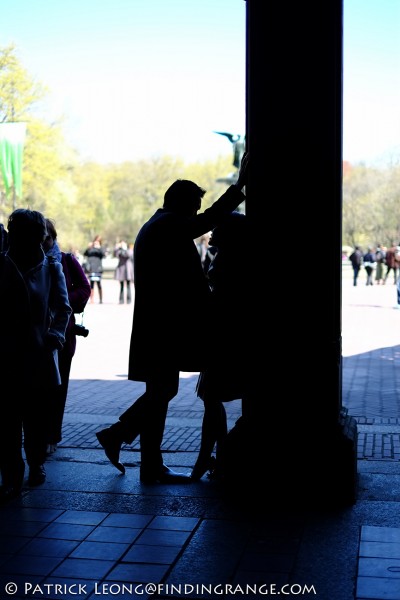
↑ Fujinon 35 F1.4 XF lens shot wide open in Central Park.
For me, I get the feeling of detachment every time I use some of these new digital cameras that are coming out these days. I don’t feel connected to what I am photographing but this is not the case with the Fuji X-Pro1. The X-Pro1 feels like an extension of me. I feel connected with it, and it makes me feel like I’m part of the action just like how my M9 makes me feel. I feel involved in the scene, and I think that’s really important especially when you’re trying to do something creative. That’s why I will always be a fan of Leica cameras, and now, Fuji X series cameras. The lack of gadgets on an M9 does not make it an inferior camera; on the contrary, it’s what liberates the camera and the photographer. The lack of gadgetry makes you concentrate on the essentials needed to take a good photograph, and it helps you get fully involved in the scene, While the Fuji is not as pure or raw as the M9 in this respect, in many ways, it still reminds me of my Leica M9, and that’s the biggest compliment that I can give any camera.

↑ Fujinon 35 F1.4 XF lens shot wide open at 3200 ISO.
So who should buy a Fuji X-Pro1? The answer is simple. A person who just loves photography, and someone who actually want to be thoroughly involved in the creative process of a photo. I can almost feel this camera sometimes tell me, “drop what you’re doing, and let’s just go out and shoot!” :). Yes, it doesn’t have image stabilization, it’s AF is not Canon 5D quick, and it can’t shoot a million frames per second. But who cares? The Fuji X-Pro1 makes you jump into the action, take photos, and actually have fun while doing it. Yes, fun…photography is suppose to be fun right?
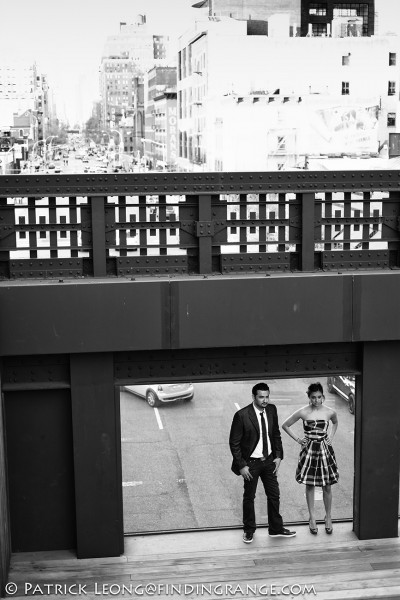
↑ Fujinon 35 F1.4 XF lens.
With the Fuji X-Pro1, you actually get to be involved in the creative process of your photos other than just hitting the big round button. You actually have a lot more control over your image rather than the computer telling you what to do all the time. In this respect, it is very similar to a Leica M9. Think about it: why do people still want Porsches? Because for the most part, you feel the road…you have a connection to it, and the feel gets communicated back to you. The Fuji X-Pro1 is very similar to this because it really gets you that connection with your subject. You’re actively involved in the photo, and after all that hard work, you get rewarded not with pure driving pleasure; you get rewarded with a beautiful photo that’s a work of art!
That’s it for this review, I hoped that you all enjoyed it. Also, please keep in mind that all photos were jpegs straight out of the camera with no photoshopping. RAW files are not compatible with Adobe Camera Raw yet. Please stay tuned for more comparisons, and mini reviews of the Fuji X-Pro1 coming soon. I was thinking about a high ISO review next or maybe a review of the video capabilities of the X-Pro1. Who knows :). Comments below are always welcomed. Thanks for stopping by!
If you’re considering buying the Fuji X-Pro1, and my review helped you decide, please help support me by purchasing from one of the links below. Thank you for your support!
Fujinon 18mm F2.0 XF Lens From Amazon
Fujinon 35mm F1.4 XF Lens From Amazon
Fujinon 60mm F2.4 XF Macro Lens From Amazon
Fujinon 18mm F2.0 XF Lens From Adorama
Fujinon 35mm F1.4 XF Lens From Adorama
Fujinon 60mm F2.4 XF Macro Lens From Adorama



an excellent comprehensive useful and in-depth review; if only the new york times could do half as well!
Many thanks for the kind words! I’m glad you enjoyed it, and thanks for taking the time out to read it! Take care!
Great review Patrick! Thorough, honest. and rightfully upbeat. I think this camera is the best alternative to the Leica M’s out there right now. But I agree with you, there is just no duplicating that “Leica” look at this point. But Fuji has taken a big step toward that. I’m really enjoying my X-Pro 1 and just wish the weather in Calif. would improve so I can get out and use it more! Thanks again for your review.
Hi Joe,
Thank you so much for your kind words, and thanks for taking the time out to read my take on the X-Pro1! On this camera being the best alternative to the Leica M, I completely agree with you. It’s also priced reasonably as well. An equivalent Leica M9 kit would cost you almost $20,000. There is no duplicating that “Leica look” but I completely agree with you in that Fuji has take a big step forward towards that. I really love the files that come out of the X-Pro1, and in my opinion, the camera handles like a dream. I hope you keep on enjoying your X-Pro1, and hopefully the weather clears up for you soon! Take care, and thanks for stopping by!
Lovely review Patrick. Enjoyed it wholeheartedly!
Hi Wasim,
Many thanks for your nice comment, and for taking the time out to read my review! Thanks for stopping by!
Great, real world, user review. Thanks!
Thank you Ken for your kind words! I’m glad you enjoyed it, and thanks for reading it! Take care!
Patrick, excellent review of the X-Pro1. I’ve had mine less than a week, but have come to many of the same conclusions you have. I haven’t had issues with focusing, and agree that it isn’t a DSLR. I’m not getting rid of my 5D mkII for it. It is simply a complement to my gear that allows me to travel lighter in situations.
For me, it returns me to the rangefinder experience I had with my M4-P’s, but gave up on as my eyesight got worse and began to rely on autofocus. I’ve been waiting for an autofocus rangefinder-like camera, and I believe I’ve found it.
Thanks again for a great review.
Hi Bob,
Thank you very much for your words, and thanks for taking the time to read it! Glad to hear that your experience with the X-Pro1 was similar to mine. You’re right, it will never replace your DSLR rig but what a great way to compliment it! You’re definitely right about how this camera returns oneself back to the rangefinder experience. That’s what I love about this camera, and it does it at a rather reasonable price as well. It really gives more people a chance to try out the rangefinder experience. Funny thing…I’m actually finding it difficult myself these to manually focus because my eyesight is not as it use to be as well, and this camera is great for people who want autofocus but also want to shoot a rangefinder. That’s a great point that you have, and I should have brought that up in my review. Take care, enjoy the camera, and thanks for stopping by!
1. expensive as for niche market yet camera body finish not elegant enough for that price, what’s wrong making it with metal and in silver chrome?
2. lens cap (both front and back) are poorly designed, keep popping off
3. good optics
4. poor AF
Having said that, bought the camera with 18mm and 35mm. Expecting more lens (made of metal please) as well as better design lens caps to come out.
I appreciate what you have to say, and I agree with some of your comments, such as, the poor lens cap design. Plus the camera is a bit light for my tastes as I stated in my review. Thanks for stopping by!
Nice jpegs! But hey, my wife gets cracking jpegs from her Canon Ixus 500 HS, and her Panasonic FZ45 produces some outstanding jpegs straight from the camera. Pardon me for bleating on, but the XP1 with its compliment of current lenses costs nearly as much as a Canon 5DMkII with a 24-105 included so what’s going on? Raw and Silkypix equals crap conversions and I want to shoot raw not jpegs, and I want decent raw files without all the fuss and bother entailed with conversion in Silkypix. If I want to shoot jpegs I will buy a point and shoot like the Ixus 500 HS and achieve jpegs even more stunning than those above. We need to stop kidding ourselves on this one or we will all end up believing the hype. Believe me I want an XP1 and I’m prepared to sell my Canon 5dMkII and L series lenses for one, but not in its current ill thought out incarnation. Not everyone is fooled by hype, so Fuji, get your finger out.
Hey Keith,
Thanks for your comment, and welcome to findingrange.com. Yeah, I agree with you. At first, I was a bit disappointed with the lack of RAW compatibility but since my review, the X-Pro1 RAW files are now completely compatible with programs, such as, Lightroom and Photoshop (even though if you ask me, it took a while). I think that’s one feature I love about my M9; Leica uses the DNG format so there aren’t really any issues with Adobe. Thanks for stopping by, and take care!
Wow! What a great review of the XPro-1. Also your website is awesome!!! I have been looking to get a X100 but have been ambivalent about whether I would be content with a fixed focus length. This is because I currently have a 550D. I wanted to get a second camera that was portable but had stunning IQ and ISO performance. Anyway your reviews have been really helpful. Keep up the good work!!
Hi Francis,
Thanks for your nice comment! I’m glad that you like the content here, and I appreciate the time you take out to read it! The X100 is a great camera. It’s just so handy, and the image quality is really good, especially for something so easy to carry around all day. If you like a 35mm focal length, then you are pretty much set! I’m a 50mm guy, so I’m actually thinking about selling my X100 for an Fuji X-E1. That might be another alternative for you to think about as well. It’s about a $1,000, and you can get one lens with it at first, which is about $600 extra. The X-E1 and lens combo would be $400 more than the X100 but you get the X-Pro1 sensor in it. Plus, the X-E1 is smaller than the X-Pro1, and you have the option of interchanging lenses in the future. If you do go for an XE-1, you should definitely check out the XF 35mm. It’s a very cool lens. Hope this helps, please feel free to write back! Take care!
After all this time, a lot has changed for the X-pro1. Not only new firmwares, also the support for RAW conversions. Under Aperture, the X-pro1 images excel, much more than they do with LR. They also do with C1. I did also perform some comparisons with the M9, but sorry, the X-pro1 at least equals this camera unless you are on the road with extremely expensive glass. My advise, don’t ever do this comparison with LR. I cannot agree under these present changes with the conclusions made: an X-pro1 user doesn’t have to be ashamed to stand aside of a Leica fanboy and the fuji user-interface is making the M9 look like an anachronism. Even the far overhyped M. I’m sure the x-system wilĺ gradually evolve into something Leica will never be able to compete with since they control the full R&D process from sensor to camera and all according electronics/ergonomics. Just like Sony, since they can built on Zeiss optical design. The future is looking bright for these amazing mirrorless cameras. Where is Nikon? Canon? Have they fallen asleep on their overly populated DSLR-ranges?
Thanks for your comment. This post was published on April 10th, 2012, and at that time, there was no Raw compatibility. So, as I stated in my review, these are all OOC jpegs. They were never put through Lightroom because I don’t use Lightroom. Also, this review is a VERY positive evaluation of the X-Pro1. I never said that a Fuji user should stand lower than a Leica user. In fact, I actually bought the X-Pro1, and I liked it so much, I also bought an X-E1 at a later date. As for Nikon and Canon, I completely agree with you. I believe that they should invest more into mirrorless cameras. Thanks again for taking the time out to comment,
Patrick
I really love your review, I’m 2 weeks in with my new XPro-1 and feel the same as you, I can’t put it down! I also use a Digilux 2 and CL, and the Fuji has brought a different dimension to my work to the Leica’s, but I love them all and glad I have them for their differences. Your review has also given me a few good pointers on the Fuji, so thanks for that too.
Best wishes,
Simon
Hi Simon,
Thank you! I appreciate you taking the time out to read my review, and congratulations on your new camera! I completely know what you mean; I couldn’t put mine down either. I love how it operates, and image quality is fantastic. There are also some nice lenses to go with the system. It’ll definitely serve you well.
I use Leica too and like you, I also love them all because they all have their individual strengths. They’re all excellent cameras. I heard great things about the Digilux 2, and it’s definitely on my list as one of the cameras I want to try one day. In fact, funny you mention the Digilux 2 because I was actually reading about the it the other day, and checking out some of the fantastic images from it. A few years ago, I almost purchased a CL but didn’t, which I STILL regret lol.
Thanks again for taking the time out to read my review. Have fun with your new camera, and I hope you visit again!
All the best,
Patrick